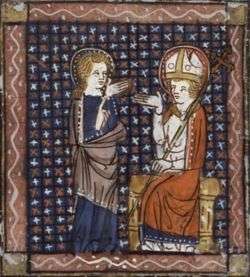Brice of Tours
| Saint Brice | |
|---|---|
|
Saint Brice and Saint Martin of Tours | |
| Born | c. AD 370 |
| Died | AD 444 |
| Venerated in |
Eastern Orthodox Church Roman Catholic Church |
| Feast | 13 November |
Saint Brice of Tours (Latin: Brictius;[lower-alpha 1] c. 370 – 444 AD) was a 5th-century Frankish bishop, the fourth Bishop of Tours, succeeding Martin of Tours in 397.[1]
Early life
According to legend, Brice was an orphan. He was rescued by Bishop Martin and raised in the monastery at Marmoutiers. He later became Martin's pupil, although the ambitious and volatile Brice was rather the opposite of his master in temperament.
Career
As Bishop of Tours, Brice performed his duties, but was also said to succumb to worldly pleasures. After a nun in his household gave birth to a child that was rumored to be his, he performed a ritual by carrying hot coal in his coat to the grave of Martin, showing his unburned coat as proof of his innocence. The people of Tours, however, did not believe him and forced him to leave Tours; he could return only after he had travelled to Rome and been absolved of all his sins by the Pope.
Sainthood
After seven years of exile in Rome, Brice returned to Tours when the administrator he had left in his absence died. He was a changed man. Upon returning, he served with such humility that on his death he was venerated as a saint. His memorial day is 13 November. The killing of the Danes in England on 13 November 1002 is called the St Brice's Day massacre.
Saint's day
In the town of Stamford in Lincolnshire, 13 November, St Brice's Day, was traditionally the day that a bull-running took place.[2]
Notes
- ↑ Also scribed as Bricius, Britius, Brixius, Briktius, or Briccius.
References
- ↑ Gregory of Tours, "History of the Franks": "De episcopis Turonicis" ("On the bishops of Tours")
- ↑ "November 13th". thebookofdays.com. Retrieved 16 November 2010.
External links
![]() Media related to Saint Brice at Wikimedia Commons
Media related to Saint Brice at Wikimedia Commons
